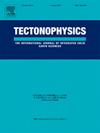墨西卡利山谷的断层相互作用和地下变形:对墨西哥-美国边界地震危险性评估的影响
IF 2.6
3区 地球科学
Q2 GEOCHEMISTRY & GEOPHYSICS
引用次数: 0
摘要
这项研究调查了在靠近美国国际边界的墨西卡利山谷最西北地区的已知和未知的地下变形结构。通过分析地震反射剖面,已经确定了帝国-拉古纳萨拉达断裂带之间的几个地下结构,包括Michoacán断层,它们的位置与地震活动模式相关。这项研究突出了Michoacán断层向北延伸超出了与美国的边界。虽然这个断层的痕迹已经在其他地方报道过,但一些证据表明,现有的变形与一个独特的、以前未知的结构有关;在此,将其命名为渐进故障。迪克西兰断层(美国)没有在msamicxico观察到;然而,这些断裂的相互作用在区域地震活动中起着重要作用。滑动分布在整个区域,而不是集中在Michoacán或Imperial等特定断层上。位于Michoacán和Imperial断裂带之间的不同方向断裂代表了Cerro Prieto拉分盆地的潜在北部边界。此外,研究区内还发现了几个子盆地。虽然本研究中使用的二维地震图像不能计算断层的滑移率,但观测到的构造提供了有关该地区位移和地下变形的宝贵信息。本文报道的构造有助于建立SCEC社区断层模型(CFM),该模型将地震反射和其他地质和地球物理数据结合起来定义断层几何形状。CFM是基于物理的断层系统建模和概率地震危险性评估的关键输入,包括统一加州地震破裂预测(UCERF3)。因此,这些发现将有助于理解区域断层的相互作用,为未来的研究提供必要的约束条件,并有助于更好地了解墨西哥-美国边境地区的地震危害。本文章由计算机程序翻译,如有差异,请以英文原文为准。
Fault interactions and subsurface deformation in the Mexicali Valley: Implications for seismic hazard assessment at the México-USA border
This study investigates both previously known and unidentified subsurface deformation structures in the northwesternmost sector of the Mexicali Valley, México, near the international border with the USA. Several subsurface structures, including the Michoacán fault, have been identified between the Imperial-Laguna Salada fault zones by analyzing seismic reflection profiles, and their locations have been correlated with seismicity patterns. This study highlights the northward extension of the Michoacán fault beyond the border with the United States. While the trace of this fault has been reported elsewhere, some evidence has associated the existing deformation with a distinct, previously unknown structure; herein, named the Progreso Fault. The Dixieland Fault (USA) is not observed in México; however, the interaction of these faults plays a significant role in the regional seismic activity. Slip is distributed throughout the sector and is not concentrated on specific faults such as the Michoacán or Imperial. Faults with different orientations located between the Michoacán and Imperial Fault zones represent the potential northern limit of the Cerro Prieto Pull-Apart Basin. Additionally, several sub-basins have been identified in the study area. Although the two-dimensional seismic imagery used in this study does not allow for slip rate calculations on the faults, the observed structures provide valuable information about displacement and subsurface deformation in the region. The structures reported here contribute to the SCEC Community Fault Model (CFM), which integrates seismic reflection and other geological and geophysical data to define fault geometries. The CFM serves as a key input for physics-based fault system modeling and probabilistic seismic hazard assessments, including the Uniform California Earthquake Rupture Forecast (UCERF3). Consequently, the findings will aid in understanding regional fault interactions, providing essential constraints for future research and facilitating a better understanding of seismic hazards in the México-USA border region.
求助全文
通过发布文献求助,成功后即可免费获取论文全文。
去求助
来源期刊

Tectonophysics
地学-地球化学与地球物理
CiteScore
4.90
自引率
6.90%
发文量
300
审稿时长
6 months
期刊介绍:
The prime focus of Tectonophysics will be high-impact original research and reviews in the fields of kinematics, structure, composition, and dynamics of the solid arth at all scales. Tectonophysics particularly encourages submission of papers based on the integration of a multitude of geophysical, geological, geochemical, geodynamic, and geotectonic methods
 求助内容:
求助内容: 应助结果提醒方式:
应助结果提醒方式:


